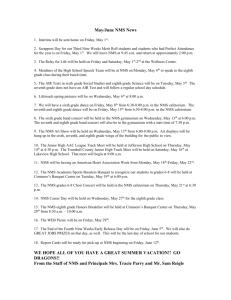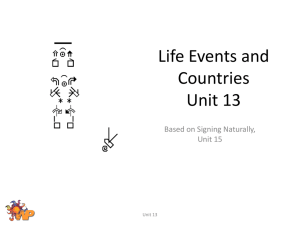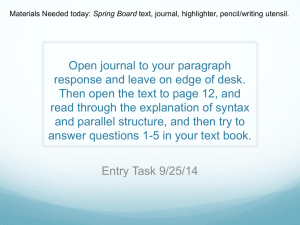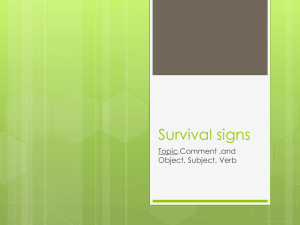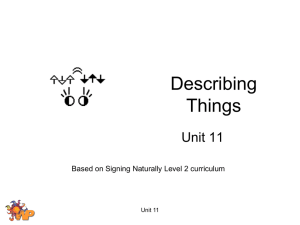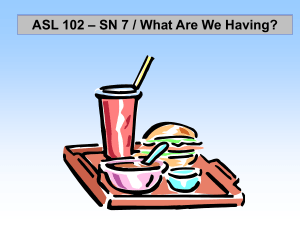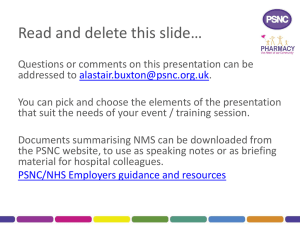NMS
advertisement
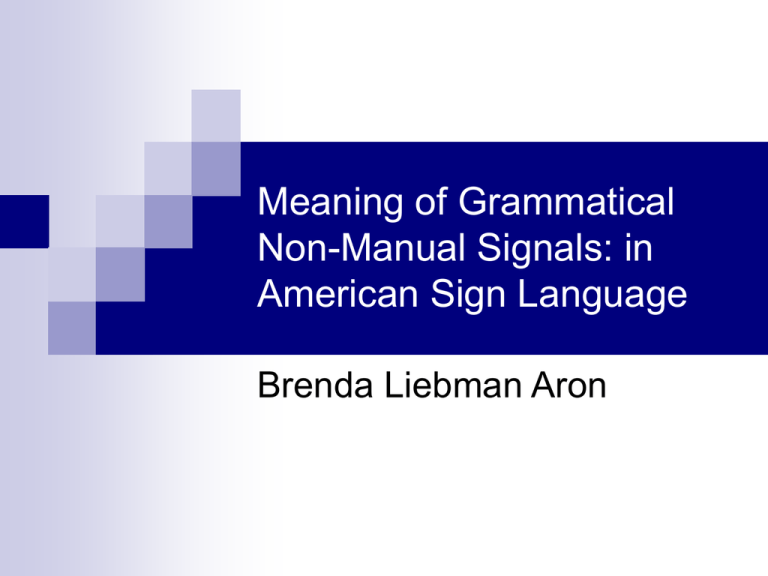
Meaning of Grammatical Non-Manual Signals: in American Sign Language Brenda Liebman Aron Non-Manual Signals in ASL Non-manual signals (NMS) or markers (NMM) consist of the various facial expressions, head tilting, shoulder raising, mouthing, and similar signals that we add to our hand signs to create meaning. There are grammatical NMS, transition markers, mouth morphemes, emotional markers, backchannel feedback & prosody et cetera My focus for this presentation is on grammatical non-manual signals. Grammatical NMS Statement Topic Comment Structure vs. Topicalization Wh-question Yes-no question Rhetorical question Negation Conditionals Relative Clause Adverbs Grammatical NMS: Statement Usually statement sentences in ASL do not signify any non-manual signal. This is also called declarative sentences. i.e.,(sentences in caps are in ASL) Subject-verb-object I HAVE CAR. I have a car. I NEED BUY BOOK. I need to buy a book. Grammatical NMS: Topic Comment vs. Topicalization Topicalization is not the same thing as topic-comment. Topic Comment means stating a topic and then making a comment. Topicalization means you are using the object of the sentence as the topic. You can use topic comment sentence structure by using topicalization. In ASL, it was thought that ASL is predominantly topiccomment or uses Object-Subject-Verb. Recent research has shown it was not true. T-C is usually used to introduce a topic however most of our syntax is S-V-O or other structures. See examples of NMS in topic-comment structures on the next slide. Grammatical NMS: Topic Comment Examples of Topic Comment Sentence Structures: *comment is also called predicates-which is a word or phrase that says something about a topic. In T-C, the eyebrows are raised and head tilted forward slightly ___t____c__(subject-object) 1. CAR? SOLD! “Remember my car, it is finally sold! _t__c__(subject-adjective) 2. HE TALL. He’s tall. __t______c__(object-subject-verb) 3. MONEY? She-GIVE-me. She gave me money. . Grammatical NMS: Topicalization __time_____topic__comment_ WEEK-PAST I WASH MY CAR. __t_______comment________ MY CAR, I WASH WEEK-PAST. Remember the eyebrows are raised and head tilted slightly forward. Using the object of your sentence as the topic of the sentence is called topicalization. In this example, “my car” becomes the subject instead of “me”. The fact that I washed it last week becomes the comment. Grammatical NMS: Wh-word questions Wh-word questions are questions that cannot be answered with just a yes or no responses and uses interrogative signs like WHAT, WHO, WHEN, WHERE, WHICH, WHY, WHATS-UP, HOW, HOW-MANY, FORFOR” Usually wh-word occur at the end of the sentence, but also occur at the beginning. NMS wh-word questions are: brows furrowed, head tilted forward slightly, Eye contact made with the person being asked the question and hold the last sign until a response is received See examples on next slide: Grammatical NMS: Wh-word questions Example of wh-word questions: ____________wh-q_ 1. YOUR NAME WHAT? ________point_wh-q_ 2. WOMAN (there) WHO? ____topic______________wh-q 3. YOU GO CALIFORNIA FOR-FOR? Why are you going to California? Grammatical NMS: Yes-No Questions Yes-no questions are questions that receives a yes or no responses. ASL does not have a sign for “DO” therefore it is embedded in the NMS structure. NMS for y/n-q: Eyebrows raised Head tilted slightly forward Eye contact made with the person being asked the question And hold the last sign until a response is received. See examples on next slide. Grammatical NMS: Yes-No Questions ______y/n-q__ 1. YOU TEACHER? Are you a teacher? _point_ y/n-q___ 2. YOU HAVE GUM? Do you have gum? point____________point y/n-q 3. YOU KNOW WHO HER? Do you know who she is? Grammatical NMS: Rhetorical Questions Rhetorical questions are not true questions since the addressee is not expected to respond but rather provide a way for the signer to introduce and draw attention to the information s/he will supply. Rh-questions are accompanied by A brow raise, Head slightly tilted A wh-word question usually occurs with this type of question. In other words, rhetorical questions differ from Whquestions is that the eyebrows are raised for rh-q and furrowed for wh-questions. Often new ASL signers would use rh-q in almost every sentence. That is not the norm for most ASL signers. We only use rh-q in specific instances. See examples on next slide. Grammatical NMS: Rhetorical Questions _________________rh-q________ 1. I FLY CALIFORNIA WHY VISIT BROTHER. rh-q_____ 2. I GO CALIFORNIA HOW FLY. ________________rh-q_________ 3. I GO CALIFORNIA WHEN NEXT-WEEK. ________________rh-q________________ 4. I GO CALIFORNIA REASON MY BROTHER WEDDING. (not a wh-word question) Grammatical NMS: Negation Negation in ASL are is usually accompanied by a headshake, Brows furrowed Sometimes the body is tilted backwards and/or adding the sign: NOT, NO, NONE, CAN’T, DENY, REFUSE, DON’T, *DON’T WANT, DON’T LIKE, DON’T UNDERSTAND etc. Negative expressions do not always require a sign showing negation i.e., __neg____ 1. ME HAPPY. I am not happy. _ neg____________ 2. PRESENTER BIG-WORDS ME not-UNDERSTAND. I cannot understand the presenter because he used a lot of complicated words. Grammatical NMS: Conditionals Conditionals express a condition upon which the topics being discussed depend. An example of a conditional sentence in English is: “If it rains tomorrow, the game will be cancelled.” Conditionals in ASL are usually accompanied by Raised eyebrows, A head tilt; A short pause between if and then Can be constructed in ASL with NMS & without the use of signs to show the conditional See examples on next slide Grammatical NMS: Conditionals _cond_____________ 1. RAIN GAME CANCEL. ___cond affirm_____ 2. YOU GO, ME GO WILL. _cond____neg_________ 3. RAIN, ME NOT GO SWIM. *There are three ways to express conditionals, with the sign for IF, # IF and only with NMS. Grammatical NMS: Relative Clauses Relative clauses is not often used in ASL. Usually if it is used, the NMS is as follows: Head tilted backwards slightly Eyebrows are lifted at the topic Eyebrows return to normal after topic Grammatical NMS: Relative Clauses rel cl._______ 1. RECENT DOG CHASE CAT COME HOME. rel cl.________________ 2. MY CAT DOG CHASE My cat, the dog chased it. _______________________neg 3. PURSE WOMAN FORGOT NOT. ____rel cl.________________________ It is not the case woman forgot the purse. Grammatical NMS: Adverbs Adverbs in ASL: an adverb modifies the meaning of a verb, adjective, or other adverb. ASL uses a number of methods to modify the meanings of signs. You can modify the speed and direction of a sign. This is called inflecting the sign. For example, SLOW or VERY ASL uses NMS to modify the meaning of signs: th for careless, furrowed brows with pursed lips means intensely; lower lip puffed a bit, head tilted back, content look on face means routine or normal. Cha means something is big or immense, Grammatical NMS: Adverbs Examples: Practice exercises FINI For more information: Contact Brenda Aron, Baron@sccd.ctc.edu
